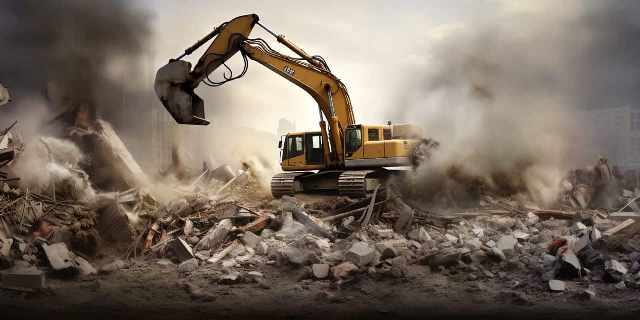by Sneha Gurjar, Director, CEM Engineers
Construction or demolition waste, commonly known as builder's waste, is responsible for urban pollution plaguing major cities nationwide. Its degrading impact spans numerous fronts, compromising air quality, increasing landfill contamination, and casting a negative shadow on the surrounding environment. This waste category significantly contributes to the array of environmental challenges that urban areas face, magnifying the urgency for remedial actions. According to The Center for Science and Environment, India generates about 150 million metric tons of construction waste, with only 1 percent of this waste being recycled within the country. This constitutes approximately 35-40 percent of the global construction waste accumulation.
The composition of construction waste predominantly encompasses dust and debris, alongside diverse building materials like Silica, Cement, and Timber dust, with various Ferrous Metals and their residues. This amalgamation of materials poses formidable health hazards, particularly through the dispersion of construction-related dust particles. Prolonged exposure to these contaminants underscores the imperative need of mitigating their release into the environment, highlighting the need for effective waste management strategies. In essence, the impact of construction waste transcends mere disposal concerns, permeating various facets of urban life. It doesn't merely breed environmental degradation and health hazards but also imposes avoidable economic burdens such as material wastage, disposal costs, and project delays. An integrated approach prioritising stringent waste management practices becomes imperative to mitigate these adverse effects, safeguarding environmental integrity while minimising health risks and economic burdens stemming from construction-related activities.
Moving towards a greener and more sustainable future
In our contemporary approach as architects, we are dedicated to conserving and promoting sustainability and environmental awareness for the benefit of future generations. Throughout construction, architects and construction professionals strategically employ measures to mitigate dust accumulation, such as erecting elevated site boundaries to confine dust within construction areas, which is especially vital in densely populated zones. This containment technique is highly effective amid ongoing construction adjacent to residential and commercial hubs, preventing dust dispersion beyond the site boundaries.
Simultaneously, architects adeptly utilise water strategically around the construction site, emerging as a natural tool to suppress dust particles, effectively reducing dust pollution and preserving local air quality. This approach significantly curtails the airborne dispersion of dust, actively contributing to a cleaner environment amidst construction operations. These proactive measures proficiently manage dust accumulation and its associated environmental impacts, showcasing architects' commitment to fostering cleaner and safer construction practices.
Further, strategically repurposing materials like wood, metal, and concrete within construction significantly alleviates reliance on new resources. Prioritising reuse and recycling minimises the demand for fresh materials, effectively curbing waste generation and fostering a more sustainable construction cycle. This approach not only prolongs the lifespan of existing resources but also alleviates environmental pressure, aligning with eco-friendly principles and lessening the strain on natural resources. Moreover, it promotes a circular economy within the construction sector, encouraging the efficient use and reuse of materials, thereby reducing the industry's overall environmental footprint. Architects play their roles by designing efficiently and planning waste reduction and more to navigate the intricate landscape of construction while actively mitigating its adverse environmental impacts, setting the stage for a more sustainable and responsible construction industry.
Redefining construction waste management
During the construction phase, it is vital to deploy barriers along site boundaries to decrease the spread of dust particles. Repurposing construction materials for these barricades not only avoids further dispersion but also impedes the release of airborne dust. Moreover, integrating fine aggregate and sand into the construction process serves as an effective measure to diminish airborne dust. These materials act as suppressants, reducing the likelihood of dust becoming airborne and aiding in containment. This strategic approach not only ensures the confinement of dust within the construction area but also minimises its impact on the surrounding environment. This method gains added strength by incorporating water in construction vehicles, ensuring a more thorough mitigation of dust dispersion. Integrating water within construction vehicles fortifies this approach, effectively limiting the migration of dust particles beyond the construction site. Maintaining cleaner vehicles decreases the risk of debris exiting the site significantly.
Another such design solution that could be adopted is Pre-engineered buildings which revolutionise traditional construction practices by relocating much of the construction process away from the site. The pre-fabrication of building components offsite ensures precision and minimises material wastage during assembly. Consequently, the reduction in onsite activities curtails dust generation, fostering a cleaner and safer environment both during and after construction.
One of the main causes of construction waste - Steel, a primary material in pre-engineered buildings, contributes significantly to the low accumulation of dust and debris. Its composition and manufacturing process inherently produce less residue, aligning with eco-conscious practices and reducing the burden of waste disposal. This shift in construction methodologies aligns harmoniously with sustainable principles, acknowledging and addressing the pervasive environmental concerns affecting our habitats. By significantly reducing the environmental footprint of construction, these practices advocate for a healthier and more sustainable future. Embracing Pre-engineered buildings showcases a commitment to innovative, eco-friendly approaches that resonate with the imperative to safeguard our environment while fostering sustainable living.
Through the collective adoption of these strategies, construction sites play an active role in mitigating dust pollution and promoting a healthier environment for workers and the nearby community. It is crucial for engineering and construction firms to prioritise these measures and capitalise on government initiatives and regulations to effectively alleviate the detrimental impacts of dust pollution on the environment. Aligning with these practices not only safeguards the well-being of individuals on-site but also demonstrates a commitment to environmental stewardship, fostering a cleaner and safer construction landscape.






